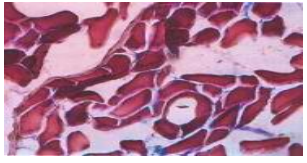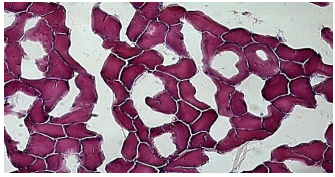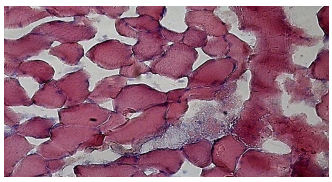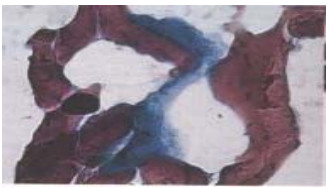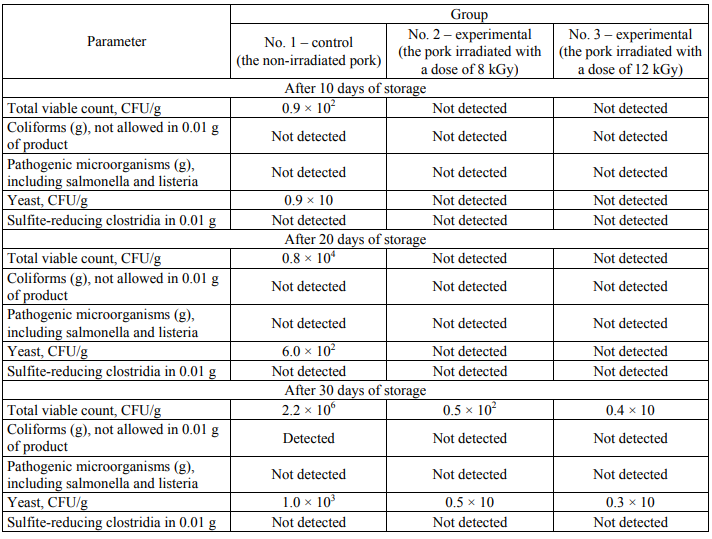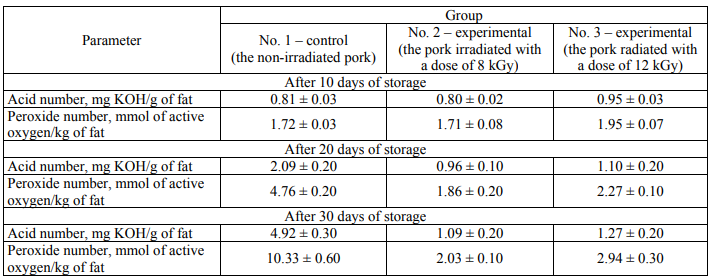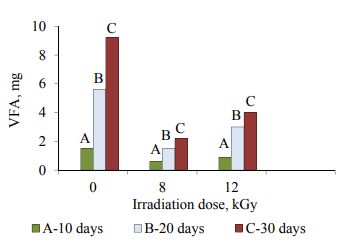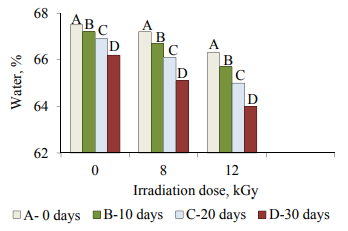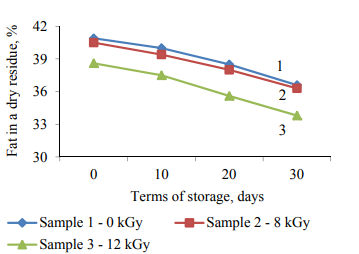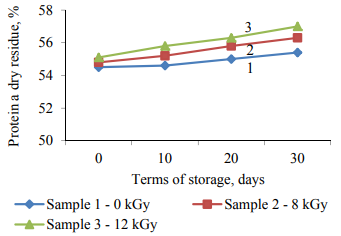Аннотация
The increase in the shelf life of perishable food products is one of the priority trends in the development of the food and processing industry. A study has been carried out of the effect of various doses of ionizing radiation on the safety of refrigerated semi-finished pork products packed in the modified atmosphere. The meat samples were processed singly by ionization at different doses - 8 kGy and 12 kGy with the help of a linear electron accelerator of a UELR-10-10S2 type with power of up to 10 MeV. The refrigerated pork neck on the bone, packed using modified atmosphere packaging (MAP) and processed by ionization at doses of 8 kGy and 12 kGy, meets the requirements of the technical regulations of the Customs Union "On Food Safety" (TR TS 021/2011) and "On safety of meat and meat products" (TR TS 034/2013) for the entire storage period. The irradiation dose of 12 kGy leads to a slight color change, an increase in the acid and peroxide numbers and volatile fatty acids, but within the limits of the norm; a slight decrease in the moisture content with a high degree of correlation of the studied indicators. The indicators of microbiological safety of the meat semi-finished products processed by different irradiation doses are within the normal range. It has been established that the higher the irradiation dose, the lower the values of microbiological indicators. The organoleptic indicators are confirmed by histological studies. The radiation processing of meat semi-finished products allows us to prolong the shelf life of the meat semi-finished products packed using MAP more than 3 times. Based on the results of the studies, it is possible to recommend the processing of meat semi-finished products by ionization at a dose of 8 kGy to increase their shelf life.Ключевые слова
Pork, processing by ionization, storage time, packaging, modified atmosphere, radiation processingВВЕДЕНИЕ
The increase in the shelf life of perishable food products is one of the priority trends in the development of the food and processing industry. To provide the quality of refrigerated meat semi-finished products, an ESL (Extended shelf life) technology is used in the process of storage, which consists in packaging products into a vacuum skin pack (Vacuum Skin Packaging) and the modified atmosphere (MAP) [1, 2, 3] For red meat, MAP is used with a high oxygen content [4, 5], since at an oxygen concentration of 70–80% oxymyoglobin is in the surface layers of meat and makes it look fresh [6, 7]. But at the same time, the high oxygen content in the package activates the oxidative processes of lipids in meat (the oxidation of polyunsaturated fatty acids), which have a negative effect on such organoleptic indicators as consistency, taste and color [4, 8], in addition, the oxygen of the medium promotes the conversion of bright red oxymioglobin into gray-brown metmyoglobin during storage [9]. The carbon dioxide of the medium prevents bacteria from multiplying in meat: at a concentration of 25%, the maximum suppression of aerobic microflora is achieved [3]. The authors of [2, 3] found that when storing pork in a vacuum skin pack and in MAP, the number of populations of psychotropic bacteria is comparable. At the same time, the lowest content of lactic acid bacteria was recorded in the pork packed using MAP. But the packaging of meat in a vacuum contributes to the oozing of meat juice, which accumulates in the folds of the surface of the packaging film, which worsens the consumer properties of food products [10] and is a medium for microbiological spoilage. It should be noted that refrigerated meat has a high water activity index. The Food Codex (USA) reflects recommendations for determining food storage conditions depending on pH and the water activity level [11]. As a result of the use of such technological methods as drying, freezing and adding preserving agents (during adsorption and osmosis), the water activity decreases, the enzymatic processes of lipid oxidation and the growth of microorganism colonies slow down. The author of [12] notes the significant role of water activity (AW) in ensuring the safety and quality of food.
But at the same time, the current technologies, despite the fact that the ESL technology is most often used in the storage of refrigerated meat semi-finished products and meat products, cannot be called perfect. Today, Russia actively introduces the technology of processing raw meat materials (except for poultry, rabbit and horse meat) by ionization. This technology can be used to process meat raw materials both in carcasses and in packaging. The processing of food products by ionization helps to reduce its microbiological contamination, which, accordingly, allows us to extend the shelf life [13–16]. It follows from the literature [17–19] that various doses of irradiation of food products may negatively affect their chemical composition. At the same time, the irradiation of food products with a significant fat content can lead to the deterioration of organoleptic indicators, since the free radicals formed during irradiation accelerate lipid oxidation [20, 21].
In this regard, the studies have been carried out of the effect of different irradiation doses on the shelf life of the refrigerated meat raw materials packed using MAP and other quality indicators during storage.
ОБЪЕКТЫ И МЕТОДЫ ИССЛЕДОВАНИЯ
To carry out the studies, three groups of meat semifinished products – pork meat on the bone from pork collar butt, were formed in accordance with the established butt cut boundaries: the anterior boundary was along the line of the head cut, the posterior boundary was between the 4th and 5th thoracic vertebrae and the lower boundary was along the ventral margin of the cervical and thoracic vertebrae (TU-10.11.10-008- 57668367 “Meat. Beef and pork cut for retail. Specifications” with a shelf life of up to 10 days at a temperature of 0 ± 4.0°C). The first group is the control group, the second and the third are the experimental ones. The domestic source raw materials were in compliance with the requirements of GOST 31476-2012 “Pigs for slaughter. Pork carcasses and semi-carcasses. Specifications”. For the study, the whole pieces of muscle tissue with the bone (cervical vertebra), with the fat and connective tissue in a natural ratio, without skin, with a thickness of lard on the surface of not more than 1 cm weighing up to 1 kg have been selected. All the samples of meat products have been packed using MAP on a Multivac packaging line, using thermoformable PVC films (the bottom film) and "SLAVAFLEX" PET//PE/EVON/PE (the upper cover film). The lower film with a thickness of 500 microns is characterized by high mechanical strength and puncture resistance. The distinctive features of the upper cover film at a thickness of 60 microns are high barrier properties, the low oxygen permeability of not more than 5 cm3 /m2/24 hours and an easy unpacking effect. As the modified atmosphere, Biogon OS-20 gas was used, consisting of 80% of oxygen and 20% of carbon dioxide.
The unirradiated products were studied as the samples of the first group meat. The samples of the second and third group meat were processed singly by ionization at doses of 8 kGy and 12 kGy, respectively. The meat semi-finished products were processed at the Center for Radiation Sterilization of the Ural Federal University named after the first President of Russia B.N. Yeltsin by a linear electron accelerator of a UELR10-10S2s model with the power of up to 10 MeV (Russia). To establish the fact of irradiation of meat raw materials, an electron paramagnetic resonance (EPR) method was used, which consisted in fixing an EPR signal with the help of a spectrometer (as a working dosimeter) due to the appearance of highly active free radicals as a result of the chain reaction of molecule excitation under ionization [22]. The experiments were carried out according to the generally accepted methods, in particular, the organoleptic indicators were determined in accordance with GOST 7269-2015 "Meat. Methods of sampling and organoleptic methods of freshness test", the microbiological indicators – in accordance with GOST R 54354-2011 "Meat and meat products. General requirements and methods of microbiological testing", GOST 31747-2012 (ISO 4831:2006, ISO 4832:2006) "Food products. Methods for detection and quantity determination of coliforms", fat – according to GOST 23042-2015 "Meat and meat products. Methods of fat determination", protein – according to GOST 25011-81 "Meat and meat products. Methods of fat protein determination", moisture – according to GOST 9793-2016 "Meat and meat products. Method for determination of moisture content", the acid number of fat – according to GOST R 55480-2013 "Meat and meat products. Method for determination of acid value", the peroxide number of fat – according to GOST R 54346-2011 "Meat and meat products. Method for determination of peroxide number", water activity – according to GOST ISO 21807-2015 "Microbiology of food and animal feeding stuffs. Determination of water activity", meat histology – according to GOST 19496-2013 "Meat and meat products. The method of histological investigation", volatile fatty acids – according to GOST 33819-2016 "Meat and meat products. Determination of volatile fatty acids by gas chromatography". The physicochemical parameters of meat semi-finished products were determined by infrared spectroscopy using a Food Scan Meatanalyser (Denmark production) express analyzer. The quality of meat was studied at the Joint-Stock Company Food Combine "Good taste" and on the basis of the Department of Food Engineering of USUE (Ekaterinburg). The results of the studies were statistically processed using such standard computer programs as Microsoft Exsel XP and Statistica 8.0.
РЕЗУЛЬТАТЫ И ИХ ОБСУЖДЕНИЕ
In accordance with GOST R 52529-2006 "Meat and meat products. Method of electron paramagnetic resonance for indication of radiation-treated meat and meat products containing bones", the source meat raw materials were studied using electron paramagnetic resonance. EPR signals were not detected in the samples studied, therefore, the products were not previously processed by ionization (Fig. 1).
The samples of meat of the control group can be referred to fresh meat in organoleptic indicators after 10 days of storage: the meat is moistened in places, red; the muscles on the cut are slightly moist and leave a moist spot on the filter paper; the consistency is elastic, dense; the dimple formed when pressing with a finger is quickly leveled; the odor is specific, characteristic of fresh pork; the lard color is white, the consistency is characteristic of pork fat – soft, elastic; the tendons are elastic, dense; the surface of the vertebrae is smooth, shiny; the broth is fragrant, transparent. After 20 days of storage, the meat of the control group is of questionable freshness: the meat is gray-red, when in contact with the film – gray; the muscles on the cut are moist, leave a spot on the filter paper, slightly sticky; the dimple is leveled slowly when pressing with a finger; after 30 days of storage, the meat of the control group is stale: covered with mucus, the color is gray with the presence of green areas; there are signs of bacterial microflora; the muscles on the cut are swollen, loosely adhere to each other, sticky; the consistency is flabby; the fat has a grayishmat shade, the slimy consistency; the connective tissue is loose with the signs of destruction; the smell of meat and odor of broth is unpleasant, harsh; the broth is muddy, with a lot of flakes resulting from the aggregation of proteins.
The meat irradiated at a dose of 8 kGy (the second experimental group) and 12 kGy (the third experimental group) after 10, 20 and 30 days of storage refers to fresh meat in organoleptic indicators. A slight change in color to brownish-red and the appearance of the smell of light oxidation plume not characteristic of fresh meat should be noted in the samples of the third group.
The analysis of the obtained histological study data by revealing changes in the microstructure of the muscle tissue corresponds to the results of the organoleptic estimation of meat. It has been established that the samples of meat of the control group after 10 days of storage and the meat of the second and third experimental groups for the whole storage period are fresh: the structure of the nuclei of muscle fibers is distinct, the color is uniform; the striation of muscle fibers is clear and distinct (Fig. 2–4).
After 20 days of storage, the structure of the nuclei of muscle fibers in the meat of the control group is indistinct, the color is non-uniform, the striation of the muscle fibers is indistinct, the muscles loosely adhere to each other, and there is a microflora in the form of weak patches. Such meat refers to the meat of questionable freshness (Fig. 5)
After 30 days of storage, the meat of the control group showed the almost complete disappearance of nuclei, the almost complete disappearance of the striation of muscle fibers, the mucilaginous areas of the surface of meat have a dark reddish-brown color; the muscle fibers are swollen, deformed, loosely adhere to each other; muscle ruptures can be noted with the formation of a fine-grained protein mass; there is a microflora in the form of multiple patches (Fig. 6).
The results of the studies of organoleptic indicators and the histology of meat are confirmed by the microbiology of the control and experimental samples of pork neck on the bone packed using MAP (Table 1).
It has been established that the microbiological parameters of pork neck on the bone of all the three groups after 10 days of storage meet the requirements of TR TS 034/2013 "On safety of meat and meat products". The radiation processing of the refrigerated meat semi-finished products packed using MAP has a positive effect on their shelf life. Thus, in the samples of meat of the second and third groups, QMAFAnM and coliforms were not detected after 20 days of storage, and after 30 days of storage all the microbiological indicators under study did not exceed the maximum allowable level. It has been established that the higher the radiation dose, the lower the values of microbiological indicators.
The microbiological parameters of pork neck on the bone of the control group after 20 and 30 days of storage do not meet the requirements of TR ТS 034/2013 "On safety of meat and meat products" in the indicators of QMAFAnM and coliforms, the yeast content has the maximum allowable value of 1.0 × 103 CFU/g.
The indicators of fat purity have been studied (Table 2).
It has been established that the acid (AN) and peroxide (PN) numbers of the fat extracted from the meat samples of the second group have lower values after 10, 20 and 30 days of storage compared to the meat samples of the control and third experimental group. Consequently, the higher the dose of irradiation, the more active the oxidation processes in meat systems, which is consistent with the literature data [20, 21]. It should be noted that AN and PN of fat in the first group after 30 days of storage is at a level of 4.92 mg KOH/g of fat and 10.33 mmol of active oxygen/kg of fat, respectively, which exceeds the norm (4.0 mg KOH/g of fat and 10.0 mmol of active oxygen/kg of fat) for fresh fat.
Figure 7 shows the dynamics of volatile fatty acids (VFA) during the storage of the control and experimental samples of the refrigerated pork neck on the bone packed using MAP irradiated at different doses.
The indicators of VFA in the experimental samples of meat irradiated at different doses correspond to fresh meat. Thus, after 10, 20 and 30 days of storage in the second experimental group, they were 0.6 mg, 1.5 mg and 2.2 mg KOH in 25 g, which is below the control sample by 60.0%, 73.2% and 76.1%, respectively. Similar results on a change in the amount of fatty acids during storage have been obtained in the samples of meat of the third experimental group: the indicators of VFA after 10, 20 and 30 days of storage are below control by 40.0%, 46.4% and 56.5%, respectively. In the samples of meat of the control group after 20 days of storage, the content of VFA is 5.6 mg KOH in 25 g, which corresponds to the meat of questionable freshness; after 30 days of storage – 9.2 mg KOH in 25 g, which corresponds to stale meat.
The studies of the chemical composition of meat raw materials during storage (Fig. 8–10) have been carried out.
The high degree of correlation of a change (decrease) in the water content depending on the radiation dose, which is within the range from 0.891 immediately after irradiation to 0.995 on the 30th day of storage has been experimentally revealed. A decrease in the moisture content in all the samples studied and a decrease in the moisture content in the meat semi-finished products during storage can be noted (Fig. 8). Thus, after 30 days of storage in the first control group, the amount of moisture decreased by 1.3%, in the second and third experimental groups – by 2.1 and 2.3%, respectively. It has been established that the processing of meat by ionization contributes to the reduction of moisture in a food product. Thus, after irradiating the samples of meat of the second experimental group at a dose of 8 kGy, there is a decrease in the water content by 0.3%, after irradiating the meat samples of the third experimental group at a dose of 12 kGy – by 1.2% compared to the unirradiated samples of the meat of the first control group. Similar results were obtained during the storage of meat raw materials. Thus, after 10 days of storage, the amount of moisture decreased by 0.5% and 1.5%, respectively, after 20 days – by 0.8% and 1.9%, respectively, after 30 days – by 1.1% and 2.2% %, respectively. The decrease in the water content is due to the radiolysis of water as a result of irradiation with the appearance of free hydroxyl groups (-OH), the atoms of hydrogen molecules and hydrogen peroxides (H2O2).
Consequently, the processing of meat by ionization increases the losses of moisture during storage, which, possibly, creates unfavorable conditions for the development of microflora.
The activity of water, along with the total content of water in the refrigerated meat, is important for the shelf life of meat. Water activity is the indicator of the presence of free water, which is a medium for the acceleration of enzymatic processes (in particular, lipid oxidation) and the vital activity of microorganisms. The activity of water after irradiation in the meat samples of the second experimental group is 0.934 units, in the third experimental group – 0.921 units, which is 0.025 units (or 2.6%) and 0.038 units (or 4.0%), respectively, lower than the meat samples of the first control group. It should be noted that the obtained results are below the mid-values of water activity for meat (0.95–1.00 units). As a result of the studies, an insignificant decrease in the value of water activity during storage has been established: in the samples of meat of the second experimental group by 0.003 units and the third group – by 0.005 units. The results obtained are consistent with a change in the microbiological indicators in the studied meat samples (Table 1). The reduction of water activity in the meat samples of the experimental groups contributes to a slowdown in the processes of microbial spoilage. It has been established that the higher the dose of irradiation, the lower the water activity indexes and the microbiological indicators. Consequently, when processing by ionization, the development of microorganisms slows down as a result of a decrease in water activity. The revealed tendency is consistent with the studies of a number of authors [23, 24].
The study of the dynamics of fat during storage has been carried out (Fig. 9).
During storage, there is a decrease in the fat content in the studied samples of meat products. Thus, in the control samples – by 4.2%, in the second and third experimental groups – by 4.3% and 4.8%, respectively, after 30 days of storage (Fig. 6). An increase in the irradiation dose of up to 12 kGy enhances the lipid oxidation processes due to the destruction of ether bonds in triglycerides with the presence of water, which is followed by the accumulation of free fatty acids, as well as peroxide compounds. The data obtained are consistent with the studies [25].
An increase in the proportion of protein in the dry residue in all the meat samples has been noted. Thus, in the samples of meat of the first, second and third groups – by 0.9%, 1.5% and 1.9%, respectively (Fig. 10). A high degree of correlation dependence of an increase in the proportion of proteins in the dry residue during storage has been established: for the unirradiated pork – 0.973, for the pork irradiated at a dose of 8 kGy – 0.997, for the pork irradiated at a dose of 12 kGy – 0.997. The protein to fat ratio in the dry residue in all the groups of samples of pork neck on the bone increases during storage: for the first group of samples at the beginning of the experiment from 1.33 : 1.00 to 1.51 : 1.00 by the end of the experiment; for the second group of samples – from 1.35 : 1.00 to 1.55 : 1.00, respectively; for the third group of samples – from 1.43 : 1.00 to 1.69 : 1.00, respectively. The protein to fat content ratio has the higher values of indicators with an increase in the radiation dose, which is in agreement with the opinion of researchers [26].
Thus, based on the results of complex studies it has been established that the refrigerated pork neck on the bone packed using MAP and processed by ionization at doses of 8 kGy and 12 kGy, corresponds to the requirements of the technical regulations of the Customs Union "On Food Safety" (TR TS 021/2011) and "On safety of meat and meat products" (TR TS 034/2013) for the entire storage period. Consequently, the radiation processing of meat semi-finished products at doses of 8 kGy and 12 kGy allows us to prolong the shelf life of the meat semi-finished products packed using MAP more than 3 times from 10 days to 30 days and more. The radiation dose of 12 kGy leads to an insignificant color change and the appearance of a slight oxidation plume; an increase in the acid and peroxide numbers of the fat extracted from meat raw materials, but within the limits of the norm; an increase in the content of volatile fatty acids; an insignificant decrease in the moisture content, water activity, the fat content and an increase in the proportion of protein in the dry residue of the meat semi-finished product packed using MAP in comparison with the meat packed using MAP and processed at a radiation dose of 8 kGy with a high degree of correlation of the studied parameters. The indicators of microbiological safety of the meat semi-finished products processed at different doses of irradiation are within the limits of the norm: the higher the dose of irradiation, the lower the values of microbiological indicators. The organoleptic quality indicators are confirmed by the histological studies of muscle tissue in accordance with the requirements of GOST 19496-2013. According to the results of the studies, it is possible to recommend the processing of the refrigerated meat semi-finished products packed using MAP by ionization at a dose of 8 kGy to increase their shelf life.
СПИСОК ЛИТЕРАТУРЫ
- Viana E.S., Gomide L.A.M., and Vanetti M.C.D. Effect of modified atmospheres on microbiological, color and sensory properties of refrigerated pork. Meat Science, 2005, vol. 71, no. 4, pр. 696-705. DOI: 10.1016/j.meatsci.2005.05.013.
- Kameník J., Saláková A., Pavlík Z., et al. Vacuum skin packaging and its effect on selected properties of beef and pork meat. European Food Research and Technology, 2014, vol. 239, no. 3, pp. 395-402. DOI: 10.1007/s00217- 014-2233-9.
- Jeremiah L.E. Packaging alternatives to deliver fresh meats using short- or long-term distribution. Research International, 2001, vol. 34, no. 9, pp. 749-772. DOI: 10.1016/S0963-9969(01)00096-5.
- Lund M.N., Lametsch R., Hviid M.S, et al. High-oxygen packaging atmosphere influences protein oxidation and tenderness of porcine longissimus dorsi during chill storage. Meat Science, 2007. vol. 77, no. 3, pр. 295-303. DOI: 10.1016/j.meatsci.2007.03.016.
- Lagerstedt A., Ahnström M.L., and Lundström K. Vacuum skin pack of beef - А consumer friendly alternative. Meat Science, 2011, vol. 88, no. 3, pр. 391-396. DOI: 10.1016/j.meatsci.2011.01.015.
- Vihavainen E.J. and Björkroth K.J. Spoilage of value-added, high-oxygen modified-atmosphere packaged raw beef steaks by Leuconostoc gasicomitatum and Leuconostoc gelidum. Food Microbiology, 2007, vol. 119, no. 3, pp. 340-345. DOI: 10.1016/j.ijfoodmicro.2007.08.029.
- Zakrys P.I., Hocan S.A., O'Sullivan M.G., et al. Effects of oxygen concentration on the sensory evaluation and guality indicators of beef muscle packed under modified atmosphere. Meat Science, 2008, vol. 79, no. 4, pp. 648-655. DOI: 10.1016/j.meatsci.2007.10.030.
- Kim Y.H., Huff-Lonergan E., Sebranek J.G., and Lonergan S.M. High-oxygen modified atmosphere packaging system induces lipid and myoglobin oxidation and protein polymerization. Meat Science, 2010. vol. 85, no. 4, pp. 759-767. DOI: 10.1016/j.meatsci.2010.04.001.
- McMillin K.W. Where is MAP Going? A review and future potential of modified atmosphere packaging for meat. Meat Science, 2008, vol. 80, no. 1, pр. 43-65. DOI: 10.1016/j.meatsci.2008.05.028.
- Li X., Lindahl G., Zamaratskaia G., and Lundström K. Influence of vacuum skin packaging on color stability of beef longissimus lumborum compared with vacuum and high-oxygen modified atmosphere packaging. Meat Science, 2012, vol. 92, no. 4, pр. 604-609. DOI: 10.1016/j.meatsci.2012.06.006.
- Food Code. U.S. Public Health Service: FDA, 2013. Available at: https://www.fda.gov (accessed 1 October 2017).
- Leistner L. and Gould G.M. Bar'ernye tekhnologii: kombinirovannye metody obrabotki, obespechivayushchie stabil'nost', bezopasnost' i kachestvo produktov pitaniya [Hurdle technologies: combination treatment for food stability, safety and quality]. Moscow: VNIIMP Publ., 2006. 236 p.
- Molins R.A. Food irradiation: principles and applications. New York: Wiley, 2001. 488 p.
- Sommers C.H. and Fan X. (ed.). Food irradiation research and technology. New York: Wiley-Blackwell, 2008. 336 p.
- Stefanova R., Vasilev N.V., and Spassov S.L. Irradiation of Food, Current Legislation Framework, and Detection of Irradiated Foods. Food Analytical Methods, 2010, vol. 3, no. 3, pp. 225-252. DOI: 10.1007/s12161-009-9118-8.
- Rozhdestvenskaya L.N., Bryazgin A.A., and Korobeynikov M.V. Background and Grounds of Using of Ionizing Radiation for the Treatment of Food Products. Food processing industry, 2016, no. 11, pp. 39-45. (In Russian).
- Kraybill H.F. Nutritional and biochemical aspects of foods preserved byionizing-radiation. Journal of home economics, 1958, vol. 50, no. 9, pp. 695-700.
- Read M.S., Kraybill H.F., Worth W.S, et al. Successive generation rat feeding studies with a composite diet of gamma-irradiated. Toxicology and applied pharmacology, 1961, vol. 3, no. 2, pp. 153-173. DOI: 10.1016/S0041- 008X(61)80002-1.
- Thayer D.W., Christopher J.P., and Campbell L.A. Toxicology studies of irradiation-sterilized chicken. Journal of food protection, 1987, vol. 50, no. 4, pp. 278-288. DOI: 10.4315/0362-028X-50.4.278.
- Štajner D., Milošević M., and Popović B.M. Irradiation effects on phenolic content, lipid and protein oxidation and scavenger ability of soybean seeds. International Journal of Molecular Sciences, 2007, vol. 8, no. 7, pp. 618-627. DOI: 10.3390/i8070618.
- Wan Norhana M.N., Poole S.E., Deeth H.C., and Dykes G.A. Prevalence, persistence and control of Salmonella and Listeria in shrimp and shrimp products: a review. Food Control, 2010, vol. 21, no. 4, pp. 343-361. DOI: 10.1016/j.foodcont.2009.06.020.
- Timakova R.T., Tikhonov S.L., Tararkov A.N., and Kudryashov L.S. Assessment of radiation safety of chilled meat using the method of electron paramagnetic resonance. Theory and practice of meat processing, 2016, vol. 1, no. 3, pp. 57-65. DOI: 10.21323/2414-438X-2016-1-3-57-65. (In Russian).
- Grosheva V.N. Research activity of water in oxygen products with dietary fiber. Modern problems of science and education, 2014, no. 2. (In Russian). Available at: https://science-education.ru/ru/article/view?id=12677. (accessed 26 September 2017).
- Morgunova A.V. Research on water activity index in frozen meat foods. Food Processing: Techniques and Technology, 2016, vol. 43, no. 4, pp. 50-55. DOI: 10.21179/2074-9414-2016-4-50-55. (In Russian).
- Zhuravskaya N.K., Alekhina L.T., and Otryashenkova L.M. Issledovanie i kontrol' kachestva myasa i myasoproduktov [Research and quality control of meat and meat products]. Moscow: Agropromizdat Publ., 1985. 296 p.
- Kozmin G.V., Geraskin S.A., and Sanzharova N.I. (eds). Radiatsionnaya tekhnologiya v sel'skom khozyaystve i pishchevoy promyshlennosti [Radiation technologies in agriculture and food industry]. Obninsk: RIRAE Publ., 2015. 400 p.



